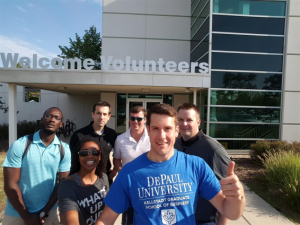Project Description:
The scope of our project was to partner with the Greater Chicago Food Depository (GCFD) and provide donations and service to help further their cause. Established in 1979, the GCFD focuses its endeavors on serving the residents of Cook County. The GCFD is a nonprofit entity that disburses food and makes a concentrated effort to help individuals in its community become self-sufficient. With our project taking place in the summer, our group was able to provide our services during a time of great need due to summer vacation and school aged children not receiving free or reduced price lunches at schools.
The overall project was multifaceted and consisted of multiple different events:
Food Drives, Physical and Virtual:
The food drives were the main events of the project. Each member facilitated their own food drive with one or more organization and also included networks of friends and family.
The physical food drives were managed by each group member by maintaining collection containers at their workplaces, social gatherings, or related institutions. Each food drive location was managed from corporate approvals, to solicitation, to delivery to the GCFD receiving center. Advertisement for the food drive was completed through email blasts, social media, fliers, and other avenues.
Working with the GCFD we had access to a virtual food drive platform hosted on their website. We were able to develop our own webpage complete with the DePaul logo and member’s desired donation group to adequately track our respective contributions. Our friends and colleagues were able to enjoy a virtual shopping experience by placing virtual food items in their virtual cart and checking which deposited their monetary donations directly to our account. This created a more appealing experience than a traditional donation process.
Golf Outing Micro Event:
Through the project planning it was recognized that we had a strong network of golf fans. Leveraging this, we created a golf event complete with donations and giveaways that we were able to secure through our corporate avenues. This event allowed our supporters to enjoy the weather while supporting our cause.

Service Day Micro Event
Each of our group members spent a day off work to participate at the GCFD warehouse volunteering their time. We spent the day working with other engaged volunteers processing incoming donations. This allowed the entire project experience to come full circle.

Analysis of Success
While collecting monetary funds was critical to our project, we decided to take the opportunity to inspire other people to join the fight against hunger. Therefore, two of our success matrices are non-monetary in nature.
Our three success metrics were all met and exceeded through the course of the project.
1) Generate $1,500 for the GCFD ($250 per team member):
We were able to more than double this goal by raising over $5175.89 in donations both monetary and physical food. We completed this by raising $4,176.69 in monetary funds and $999.2 worth of physical food donations by the conversion rate of $1 = 1.25 lbs. of food. To top this off, we can see by the conversion of $1 = 3 meals, we were able to supply 15,528 meals into the hands of those that would have otherwise gone hungry.
2) Raise awareness to GCFD’s mission and help promote sustainable giving:
Through the project, we were able to interact with many people during the food drives at various communities. Many people expressed their support to the cause through donations and kind words and expressed interest in future involvement. Through our project we believe that we have truly brought awareness to the GCFD cause through this project. This may be the most important aspect of our success!
3) Team members to donate one day of service at GCFD warehouse:
Each of our team members successfully took a day of absence from their respective workplaces and families to participate in a volunteer day at the GCFD. During this day we were able to assist in the sorting and repackaging of over 30,750 pounds of potatoes!
Advice for Future Teams
Choosing a partnering organization that will support you is critical. By partnering with the GCFD, we were able to take advantage of an online virtual donation platform, boxes and bins for donations, and a helpful contact. He was able to answer our questions and guide us through a successful project.
Get started early. It goes without saying that you will not have much time to complete your project. The earlier that you can get the wheels turning the more impact you will have. You will be working through corporate red tape, production schedule, and other items which all take time.
Lessons Learned:
Communication was incredibly important due to such a large amount of information to flow through multiple stakeholders. Our team made it a point to over- communicate in an attempt to ensure the proper flow of information and ideas. This proved helpful on many occasions. One issue that we experienced was not choosing the most suitable platform to complete this in however. Most of our communication was via email which quickly became cumbersome to extract information from. Utilizing alternate project management tools to collect and store information would have been beneficial.
Identifying tasks of our project in the project inception and assigning responsibilities to team members helped to streamline the project. By spreading out the workload it allowed each member to focus on specific tasks and be responsible for completion. Additionally, members assigned to tasks that they enjoy or have specific strengths in enhanced the quality of deliverables.


